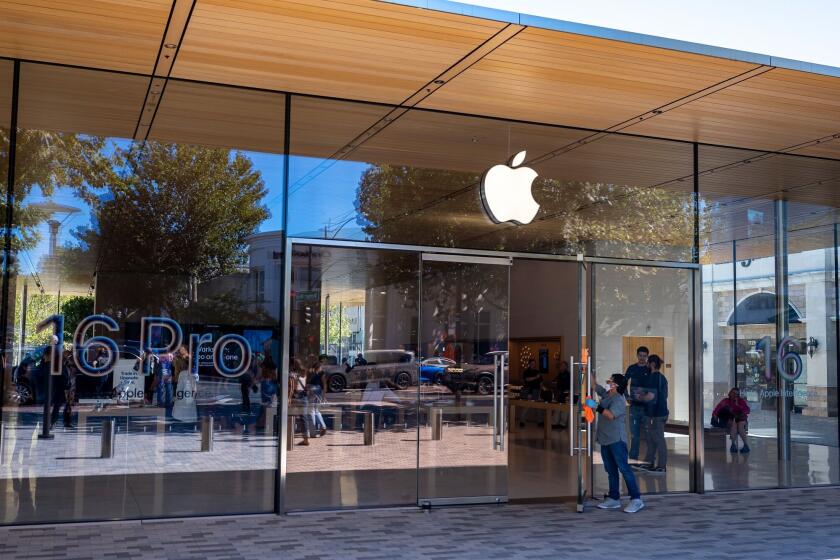Southland’s retail recession spreads
- Share via
In the heart of affluent Studio City, “for lease” signs dot the Ventura Boulevard shopping district, and cars zoom past vacant storefronts.
“This was the main drag historically,” said Lynn Crandall, who owns an art sales and picture-framing business on Ventura near Laurel Canyon Boulevard. “Now it’s become like a ghost town.”
It was a similar scene over the hill, where on a recent afternoon shopkeeper Norman Duarte sat alone in his boutique in the quiet of once-bustling Montana Avenue in Santa Monica.
In better times, Duarte’s menswear shop, Station 25, got visits from fathers who had left their children off to paint plates at nearby Color Me Mine. But the pottery studio has closed its doors. So have a raft of others, including the flagship store of Rachel Ashwell Shabby Chic, which called it quits last week.
The snowballing retail recession, which had initially hit shopping centers in the troubled Inland Empire and overbuilt parts of Orange County, has finally reached wealthier parts of the region, leaving empty storefronts from the deserts to the sea.
In Los Angeles and Ventura counties, the vacancy rate in the first quarter rose more than 50% over the previous year to more than 3% and asking rents fell from an average of $2.29 a square foot per month to $2.14, according to the real estate brokerage CB Richard Ellis Inc. Vacancies increased 16% in Orange County and 11% in the Inland Empire.
A big part of the problem, broker Michael Epsteen said, is that some landlords hiked rents greedily during the boom years, particularly in upscale urban shopping districts such as Montana Avenue and parts of Melrose Avenue and Robertson Boulevard in Los Angeles.
When the market was hot in those hip locales, competing landlords “saw the other guy get away with murder” and hiked their own asking rents, Epsteen said. Rents on the hottest blocks of Robertson, for instance, quadrupled since 2006 from about $6 a square foot per month to as much as $25.
“They must be falling now,” Epsteen said. There are more than 20 vacant stores on Montana Avenue, and vacancies will soon “be popping up on Melrose -- wherever people overpaid,” he said.
It’s even worse in areas hard-hit by the housing bust. In the eastern end of San Bernardino and Riverside counties, where hundreds of new housing tracts sprang up in recent years, the retail vacancy rate is almost 16%, according to CB Richard Ellis.
When storefronts become vacant, the investors or landlords who own the shopping centers collect less money in rent. Moreover, the retail difficulties are giving a bargaining edge to those tenants who’ve been able to hang on, and many have been negotiating cheaper leases. In some cases, landlords in the Los Angeles area have dropped rents between 20% and 40%, brokers said.
“Requests for rent reductions came piling in for all our landlords, like ants in an ant farm,” said Scott Kaplan, a senior managing director at CB Richard Ellis.
With their rental income falling, some landlords are having trouble paying their mortgages and may face foreclosure. Banks have been reluctant to take over malls so far, but that patience may end soon, industry observers said.
“We’re in the beginning stages of banks taking back assets,” Kaplan said. “We’ll see a lot of that occurring between June and December.”
In addition to reduced income from rents, many owners of retail space are finding that -- like homeowners -- the value of their property has dropped considerably.
Those who bought their properties during the recent boom may be upside down on their mortgages, industry observers said.
Although many banks are still trying to avoid foreclosing, some are trying to improve their bottom lines by calling for landlords to put in more equity if they want to keep their loans, Kaplan said.
“Then they have a staring match to see who flinches,” he said.
He predicted that commercial owners and lenders would soon come to terms with what property is worth now, and that property would be re-priced downward through foreclosures and sales.
But that will take some time, as long as 12 to 18 months, according to some analysts.
“There is a huge volume of stuff in trouble and only a tiny bit of it resolved,” said analyst Peter Slatin of Real Capital Analytics.
Meanwhile, empty storefronts are a growing nationwide trend, said economist Bob Bach of brokerage Grubb & Ellis. “Vacancy rates are rising rapidly.”
One result, Bach said, is that landlords have recently been willing to lease to tenants they might have avoided in the past as not up to snuff or not appropriate for the center’s mix of businesses.
Examples include dentists, chiropractors, charter schools and “affordable pampering” facilities such as massage therapy clinics, said analyst Alexander Goldfarb of Sandler O’Neill & Partners. Those types of businesses are more likely to end up in weaker malls, he said.
“Top-tier malls are likely to retain their status and perform well,” he said. “But lower-quality centers are more vulnerable.”
Upscale malls are more able to attract retailers such as Forever 21 that are in an expansion mode. The recession has paved the way for the low-price, trendy clothier to get its stores into bigger quarters and expand its offerings, said Larry Meyer, an executive vice president.
The Los Angeles company is moving into spaces vacated by defunct retailers Mervyns and Gottschalks. One of them is in Los Cerritos Center in Cerritos, where Forever 21 has stripped out a former Mervyns department store and is using the space to build a new Forever 21 in the large mall.
But the smaller shopping strips, like Montana Avenue or Ventura Boulevard, that cater to small businesses remain vulnerable.
Crandall, who has operated Decor Art Galleries in Studio City for 15 years, said there was always turnover among businesses on Ventura Boulevard.
But newcomers have stopped grabbing up empty spaces.
She blames some nearby landlords who started raising rents dramatically around 2005, when the economy was strong and chain stores with deep pockets were moving into the San Fernando Valley neighborhood.
Crandall’s landlord, like many others around the region, provided some rent relief this year.
But other tenants weren’t so lucky. When the recession came and consumers cut spending, it grew hard to make the high payments, and many merchants went out of business.
Said Crandall: “When people stop spending, how do you cope?”
--
More to Read
Inside the business of entertainment
The Wide Shot brings you news, analysis and insights on everything from streaming wars to production — and what it all means for the future.
You may occasionally receive promotional content from the Los Angeles Times.











